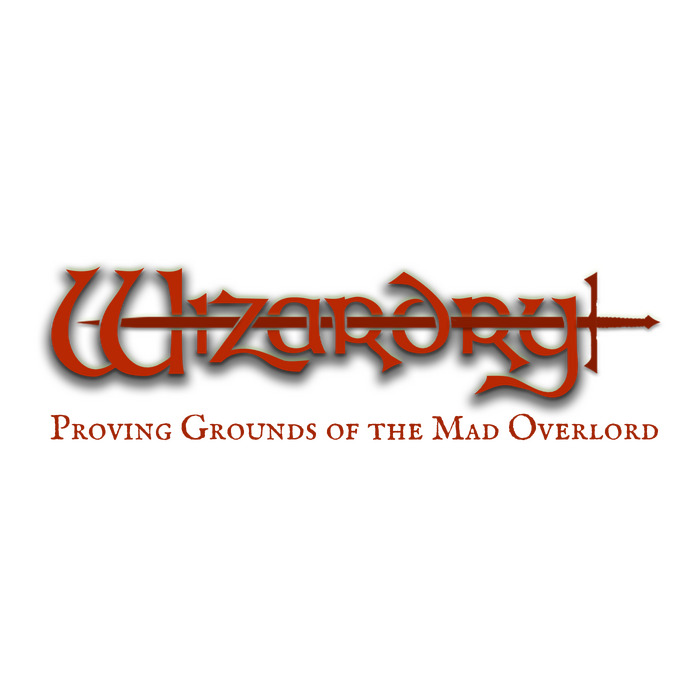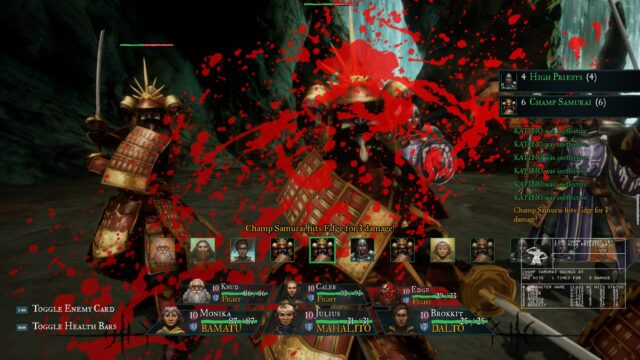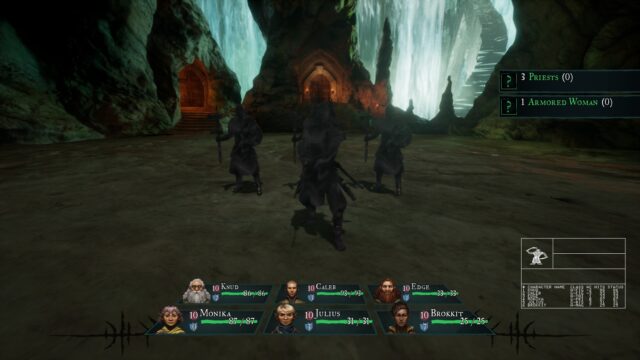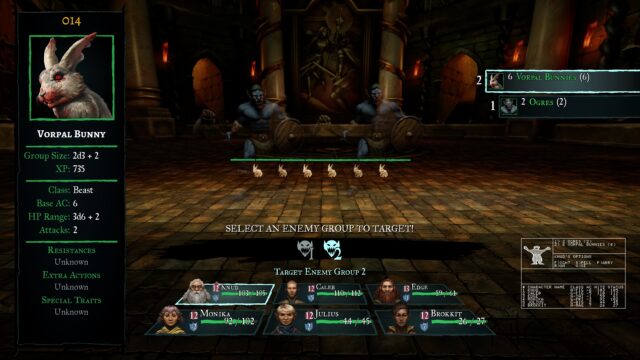Wizardry: Proving Grounds of the Mad Overlord Review
Sally Forth Brave Adventurers
The video game industry is constantly shifting. As an entertainment medium it has only been around for half a century, and yet, even the earliest of titles have grand legacies. Wizardry has been around since 1981, dazzling audiences with a tabletop-style dungeon crawl brought to life. Digital Eclipse has elected to bring back these early days of gaming with a remake of classic turn-based dungeon crawler Wizardry: Proving Grounds of the Mad Overlord. While it has a few modern amenities and glossy visuals, the remake still harbours the most unforgiving of gameplay for those unaware.
In Wizardry: Proving Grounds of the Mad Overlord, players are contracted by their local Lord Trebor to dive into the nearby labyrinth to retrieve his lost amulet from the wizard Werdna. The early floors of the labyrinth have little messages scrawled out that players can read, but that’s it for the story. There’s no offering of gold or other riches, just a good luck wave. This is thoroughly in keeping with the original release, and Digital Eclipse’s remake is built on the original code. The harrowing journey through the labyrinth comes entirely from the gameplay.
This minimalistic way of thinking is extremely nostalgic. For the philosophically inclined there’s little to grasp onto as Trebor and Werdna are simply props to propel this sadistic dungeon crawler forward. There’s no hand-holding, just an uncaring dungeon that can alternate between throwing the simplest of fights the player’s way and other times just brutally beats them down. Sometimes it isn’t fair, and the first labyrinth floor may be the graves of many party members, never mind making it all the way to the tenth and final floor. The meticulously created map and the diverse bestiary make every step a gauntlet, every decision a potentially final one. These are the memories that make this nostalgic romp a consistently gratifying journey.
Players can tailor the nostalgia of Wizardry: Proving Grounds of the Mad Overlord. There’s a menu to enable or disable settings to make things as authentic to the original 1981 Apple II version or slightly updated 1990 NES one before creating a character. Meanwhile, those who want to make things more easily manageable have some modern quality of life options. Modern doesn’t necessarily make things easier though; while amenities like an inn and the resurrection of a level one characters can be free, this does little more than assist in keeping players from being stuck in the character creation screen for too long. Meanwhile, players can at least opt for assigning attribute points instead of rolling for them and ending up with characters that may not be that usable.
A lot of memories are made from growing attached to the characters that the player creates. Players create a party of up to six members from typical fantasy classes. Fighter, priest, thief, and mage are able to be created from the start, while specialty classes can be unlocked with certain attribute points later on that mostly combine various traits from the core four. For example, lords are a combination of fighter and priest, while samurai mix fighter and mage. Elsewhere, ninjas are more versatile thieves, with bishops combining spells from both priest and mage while being able to identify items found in the labyrinth.
The party is split into three front row and three back row characters. Thieves that spend a turn hiding to then ambush are the only class that are able to physically attack from the back row. This usually leaves priests and mages to rely on their limited spell slots before having to return to town to recharge. Since defeating enemies quickly and keeping players alive relies so much on these spells, there are frequent trips back to town. Every death that players have in the dungeon may result in wasted gold since the temple in town may fail and turn the body to ash, where it costs double. A body that is ash also may not revive, in which case that character is gone permanently. There is no way to avoid this, meaning characters can disappear in the blink of an eye. Experience and knowing how to approach combat is very important; encountering a new monster is a nail-biting situation that can easily turn to disaster.
Wizardry: Proving Grounds of the Mad Overlord has moments where careful planning can be derailed by bad luck. One factor for this is randomized initiative, though players can increase an attribute to improve the likelihood of going first. Every party member plays a key role, and one wrong turn can mean a character death or party wipe. Encounters can occasionally feature friendly enemies that players can still choose to attack or leave in peace, while there’s also a chance for either side to be surprised. Surprise turns don’t allow the casting of spells, making them a round of potshots before the real fight begins. Ultimately fights boil down to an arms race of whether the player’s arsenal of spells can decimate the enemy before they get the chance to do the same.
Magic ramps up through the game, with both players and enemies beginning by targeting one creature at a time, both moving to full monster groups and then entire encounters. The likelihood of getting these overpowered spells isn’t guaranteed either as characters get a random allotment of magic from the spell level that is learned. Unfortunately for the party, it counts as a single group, but monsters can be annoyingly split into up to four groups of one-to-ten combatants each. This makes some fights that seem easy, like a group of kobolds, end up devastating if they come in too many numbers with undead kobolds and orcs mixed into that as well. It can feel like Wizardry: Proving Grounds of the Mad Overlord is set up to make sure the players are taken unaware at every turn and players can only hope to be as prepared as possible.
There are two main types of encounters, outside of three scripted areas that could be called two sub-bosses and the final boss. First are random encounters that appear while walking around the labyrinth floors. The fights are frequently ill-timed, but provide extra experience and don’t appear all that often. Balancing these out are guardian encounters. These guardians can appear after entering certain doors on any given labyrinth floor and, while still random, give the added benefit of a treasure chest. However, finding treasure is a double-edged sword. Chests are almost guaranteed to be trapped and these traps vary from annoying to devastating. Thieves mitigate the risk, but can still fail and without a bishop, players have to spend the worth of the item to identify it. Thieves are rather weak combatants and bishops only learn the most basic spells of each priest and mage, so taking them into the labyrinth is going to make the overall party weaker. Luckily, if players don’t mind taking up a little extra time a bishop can be holed up in town as a free appraisal service to swap out, and thieves can ambush from the back row if they end up weaker than a sturdy priest.
While updated for more modern sensibilities, the true heart of Wizardry: Proving Grounds of the Mad Overlord is old-school. Having a backup party is a prerequisite as something is bound to happen along the way. Being reliant on a single party will easily result in effectively having to restart should they meet their end. Even with the modern settings implemented the game isn’t for the faint of heart. Ultimately, it either leads to joy at the challenge or recoiling at the unforgiving nature. This caters the title to a niche audience, but embracing that, warts and all, is a welcome aspect nonetheless.
Although built upon the original 1981 code of the game, Wizardry: Proving Grounds of the Mad Overlord has received a lot of visual upgrades. Enemy designs are detailed and crisp, leading to fun animations for attacking and another when they do damage. The most amusing visual flourish is how the entire original 1981 game is playing at all times. The player can choose to display it in small box on screen, use it as the full visual representation, or hide it, but it’s still there running the entire time. This is a great way to honour the old while making something feel new again. Meanwhile, there’s an auditory ambiance that makes every step in the labyrinth full of dread. It is a persistent case of tension with violin crescendos that cause unintentional peaks over the shoulder to avoid unseen danger. Combat and town music are ultimately passable, being upgraded to make the experience well-rounded.
The addition of extra layers and modernity to a classic old-school dungeon crawler makes Wizardry: Proving Grounds of the Mad Overlord‘s remake an enjoyable accomplishment. The gameplay is still punishing, but it’s more manageable with added layers of strategic planning to make bad luck easier to swallow, while the presentation’s overhaul adds enough to make everything feel exciting to be a part of. The biggest detriment is that it is perhaps too faithful to the original as the punishing difficulty is sure to turn some away even as it brings turn-based thrill-seekers ever closer to see just how hard these games can really be. So, with that in mind, there’s still a lot to enjoy in this faithful remake of a true classic.
Disclosure: This review is based on a free copy of the game provided by the publisher.


A truly faithful update of a classic
More accessible, but still punishingly difficult
Combat is always a tense joy to participate in
A little too old-school
Punishing difficulty can turn players away










Recent Comments